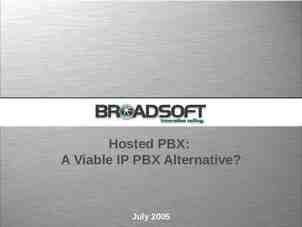Introduction to Internet Exchange Points Concept and Models of IXPs
47 Slides910.50 KB

Introduction to Internet Exchange Points Concept and Models of IXPs

Overview of IXPs around the world

IXP density around the world 119 countries with IXPs 84 countries without IXPs America, Brazil and Europe have the highest density of IXPs North, West Africa and Middle East are regions with least IXPs Source: Packet Clearing House, Internet exchange point directory reports. Retrieved on November 18, 2015 from http://wwww.pch.net/ixpdir/summary

IXP Growth Per Region Latin America recorded the highest percentage growth Europe has the highest number of IXPs and aggregate traffic Asia-Pacific exchanges more traffic than N.A despite having less IXPs Africa 2nd in % growth with lowest number of IXPs and traffic exchanged Source: Packet Clearing House, Internet exchange point directory reports. Retrieved on November 18, 2015 from http://wwww.pch.net/ixpdir/summary

Summary of North America IXP Due to the history of the Internet and the US the first IXP’s known as Federal Internet Exchanges (FIX) East and West were built in 1989 under the NSFNET Soon after the first Commercial Internet Exchange (CIX) was built on the West Coast. In 1990 the 1st commercial IXP Metropolitan Area East (MAE) on the East Cost (Wash. DC) Thereafter the NSFNET awarded contracts for the running of 4 Network Access Points (NAPs) Over the years traffic reduced from the NAPs to Private Interconnections There are over 90 IXPs in the US today most of which are commercially operated. Most of the IXPs are owned and operated by Data-Center companies

Summary of Latin America & Caribbean IXPs The LAC region is as diverse as the Asia-Pacific region. The IXPs are commonly referred to as Network Access Points (NAPs) Brazil and Argentina are the most developed in the region. Brazil has the highest number of IXPs with 23 run by IX BR (formerly known at PTT metro) as non-profit organization under the CGI Policy and regulations vary from one country to another for instance Chile requires each IP operator connect to a NAP Regional connectivity for the region happens mostly in Miami, USA due to historical reasons The Caribbean Islands of Haiti and Netherlands Antilles have IXPs.

Summary of Asia-Pacific IXP There is a large difference in the countries within Asia on the level of Internet access and connectivity. First free IXP in Asia was Hong Kong Internet Exchange (HKIX) administered by the Chinese University of Hong Kong (CUHK). IXPs in Asia have been formed through various models but largely remain non-profit entities either through academia or ISP association. Most of the large IXPs in Asia are located along the major cable landing points such as Hong Kong, Singapore, Tokyo and Seoul Unique Language is one of the key factors that has driven growth of traffic in the Asian-Pacific region. Presently there 20 Countries with IXPs out of the 58 countries under the APNIC region representing 34%. Policies and regulation vary from one country to another for instance Malaysia requires operators to connect to IXPs.

THE IXP CONCEPT

IXP Description An Internet exchange point (IXP) enables local networks to efficiently exchange information at a common point within a country rather than needing to exchange local Internet traffic overseas. Therefore an IXP is a component of Internet infrastructure that can increase the affordability and quality of the Internet for local communities.

IXP Analogy Airports and IXPs Objective of airports is offer an efficient transit point for passengers – Similar to IXPs Airlines are traffic driven similar to Internet carriers/operators. Destinations for both Airlines and Internet Carriers are predetermined based on the locations value proposition and potential traffic volume Most importantly the facility’s ability to attract more carriers and efficiently handle the traffic Facility features and services are value added services Airport Example: DXB The 4th busiest by International passenger traffic and 14th busiest by overall passenger traffic as of 2012 6th Busiest by cargo traffic as of 2012 In 2010 DXB handled over 47.2Million passengers. Plans are underway to extend the airport to handle 80million passengers by 2012 and 90 million by 2018. Shopping, real-estate and regional financial hub status in addition to ease of connecting eastbound and westbound attract passenger traffic

How IXPs Work The Internet is an interconnection of networks, each controlled by separate entities Those entities are generally called Internet Service Providers (ISP), and the networks they control are called Autonomous Systems (or AS) RFC1930. In order to have connectivity to the "global Internet", the AS of an ISP must be connected to the AS of at least one other ISP which already has "global Internet" connection. This is called "buying transit", as the process usually involves an economic transaction. Autonomous Systems are interconnected via the BGP protocol RFC4271.

How IXPs Work All Internet Service Providers must buy transit, with the exception of a small number of very large ISPs (called "Tier 1" ISPs), who get global Internet connectivity simply by being interconnected with each other. In this model, all Internet traffic flowing between smaller ISPs (also called "Tier 2" ISPs) has to pass through their upstream providers' networks. Some of the Tier 2 ISPs decide to interconnect their AS directly, in order to reduce the amount of different networks (the number of 'hops') the traffic has to traverse, and at the same time save some transit costs. This practice is called "peering”.

IXP Do’s and Don’ts IXPs are not, generally, involved in the peering agreements between connected ISPs; IXPs do not provide services that compete with its members IXPs do however have requirements that an ISP must meet to connect to the IXP; All IXPs have rules for correct use of the IXP.

STARTING AN IXP

Starting an IXP It is not possible to define a specific set of instructions for starting an IXP; every new IXP will face different challenges, and operate under different economic, technical and legal circumstances. However, the experiences of the existing IXP’s will aid the discussions for the stakeholders to reach mutual consensus.

IXP STARTUP CHALLENGES

IXP Startup Challenges Most IXP established will experience low traffic volumes. This in itself is a cause for concern for most members interested in helping to establish an IXP The incumbent operator often resists connecting to the IXP. This is attributed to the perception that they will loose their traffic by peering with customers. The lack of full technical understanding about how the IXP operates and sufficient technical capacity to setup the IXP is a hidden concern for some operators. The existing regulatory regime and policies may hinder the growth of the IXP. For instance policies that inhibit competition on broadband terrestrial infrastructure may limit the options available for local interconnection.

IXP Startup Challenges In many emerging Internet economies there are challenges on broadband terrestrial infrastructure (such as fiber and copper) that range from availability, costs, and quality of service. Where broadband terrestrial infrastructure challenges are prevalent, the use of wireless solutions in both open and closed spectrum is dominant but prone to interference resulting in poor reliability. As a result, this can affect the use of the IXP as a reliable peering point. Implementing a sustainable model to support the IXP operations is often met with some resistance. This is due to the perceived low value derived by members from peering at the new IXP.

IXP MODELS

Institutional and Operational Models for IXPs A variety of institutional models have been adopted to operate IXPs. They fall into four categories: Nonprofit industry associations of ISPs Operator-neutral commercial and for-profit companies University and government agencies Informal associations of networks

Commercial vs. Non-Commercial Most European IXPs grew from non-commercial ventures, such as research organisations Most African IXPs were established by ISP Associations and Universities By comparison, in the US the majority of IXPs are commercial, and some commercially run IXPs have emerged in Europe Most of the emerging IXPs have opted for a noncommercial approach.

Why Consider a non-Profit model Most emerging IXPs have a common objective of their founders to improve Internet connectivity rather than being built as a company. The involvement of non- commercial entities such as NRENs, ccTLDs and governmental institutions, it is easier to establish an IXP as non-profit entity A non-commercial entity is possibly better placed to maintain neutrality.

IXP Neutrality Whether commercial or not, virtually all IXPs are owned and managed neutrally with respect to carriers, ISPs and co-location providers. An example that is often quoted is a group of IXPs in the US, which are owned and run by a carrier. The only circuits that may be used to gain access to the IXPs must be purchased from that carrier, thus producing a monopoly situation. Many ISPs have expressed strong feelings about the importance of neutrality of IXPs, and most of the larger European IXPs attribute their success to their neutrality.

Cont’d IXPs generally prohibit themselves from carrying out any activity that may compete with member/customer business activities. If an IXP competes with members/customers it could lose their support. The important point is that the ownership and management of the IXP should always remain neutral.

Ownership Neutrality could be compromised if a member ISP owns parts (such as equipment, etc) of the IXP and is acquired over by another organisation The new owner may not honor previous arrangements and may impose their own limitations that are unfriendly to the IXP members The concern is the potential for disruption or even complete breakdown of the IXP should a major change occur to an involved party who has title to part of the infrastructure.

Cont’d Many IXPs begin with donations of equipment, rack space, labour and other assistance - that is part of the cooperative nature of most start up IXPs. In case of donations, sponsors should put in writing the nature of the agreement for the IXP to use the equipment. It is the responsibility of the IXP to consider maintenance and insurance of the equipment Many successful IXPs have worked well by existing with some risk, on the understanding that, as a co-operative organisation, it would be in no single entity's interest.

Cont’d In many examples of the creation of an IXP there is no formal body - the IXP is run and managed by general consensus between the parties involved (often the ISPs which will benefit from the presence of an IXP). This is probably the most efficient and easiest mechanism for a start up IXP. There are issues that arise as an IXP grows that suggests that a 'free form' purely consensual based model will not scale. The 'consensual' based model can still be true when the IXP has been developed from an established organisation such as a research or academic institution.

Cont’d Whilst the institution itself will probably have well defined management structures for its original purposes, these may not be particularly applicable to the management of an IXP, and in some cases could be a drawback. These are some of the reasons why a nascent IXP should consider its formal management structure as early as possible. There is no one right management model, but careful consideration of the future management of the IXP The structure should assist the IXP to be self-determining, remain within legal and regulatory constraints, maintain neutrality and establish financial security.

Scope of the IXP The scope of activities that the IXP should carry out is worthy of early consideration. Although this is likely to be a matter for continual assessment as the IXP grows, and the profile and requirements of its members changes Some IXPs limit themselves to purely providing a switched infrastructure, Others offer extra technical services (e.g. route servers, private interconnects) some IXPs carry out non-technical activities for the benefit of its members, acting, to varying extents, as industry associations.

Cont’d These latter activities can be contentious, some ISPs want their fees to fund only the IXP physical infrastructure. Also these activities can often be country specific, and therefore being of limited benefit to ISPs not based in the country of the IXP. Most IXPs have mailing lists and meetings for their members. This means the IXP can be a natural forum for discussion of subjects of interest to the industry in general.

Cont’d How far an IXP should involve itself in these activities is, of course, a matter for the individual IXP, its mandate, and its members wishes. Whatever involvement the IXP decides to have outside of providing the basic switch infrastructure, it is important that it has the support of its membership, and that the activities are documented so that there is transparency for existing and prospective new members.

IXP INFRASTRUCTURE

IXP Architecture: Layer 2 ISP 6 ISP 5 ISP 4 IXP Services: TLD DNS, Routing Registry Ethernet Switch Looking Glass, IXP Management Network news, etc ISP 1 ISP 2 ISP 3 The vast majority of IXPs have adopted a layer 2 switched Ethernet architecture.

IXP Equipment The IXP Core is an Ethernet Switch (Mandatory) Therefore invest in the best and most expandable equipment that its financial circumstances allow. Having 2 switches is good for redundancy if the funds can allow. Address Space (Mandatory) The IXP will require IP address space for the peering Switch fabric. IP addresses are requested from the regional RIR (AfrINIC) Other Mandatory IXP equipment: Where the IXP is located in a datacenter other mandatory equipment are built into the facility. Where the decision is to host the IXP outside a datacenter facility, additional equipment will be required and are discussed in the IXP location slide.

IXP Equipment Route Server (Optional) During the initial stages of setup having a Route Server provides ease of configuration for new members Direct peering between the IXP members can be implemented in the absence of a Route Server Web and Mail Servers (Optional) An IXP will require servers to host email, mailing list, website and monitoring (usage stats, etc) Where there are limited funds, members can offer to host the services on their services. Transit Router (Optional) This will be to provide Internet access to the IXP website, email and staff Internet access. Transit can be provided through a members IXP Router on a different interface. Route Collector (Optional) Also referred to as a looking glass which assists IXP members with troubleshooting. It can also be used to collect routes for statistics measurements.

Location The location of the IXP is very important. The IXP location should be neutral and low cost. In considering the IXP location the following factors should be considered; i. ii. iii. iv. v. vi. vii. Space Environmental Control Security Power Access to terrestrial Infrastructure Cabling Support

IXP Services There are a number of basic services that an IXP can offer to its members beyond the shared switch infrastructure. These services are at the discretion of each IXP and do not in any way compete with its membership. The following is a list of basic services that can be offered by the IXP i. ii. iii. iv. v. Shared switch infrastructure Website Mailing list Member route hosting/co-location Route collector vi. Route Collector vii. Private Interconnects viii. IPv6 and Multicast Services ix. Multi Site Access x. Industry Association & Policy Other IXP Value added services will be discussed in the next session

Personnel It is likely that a start up IXP will not have any directly employed staff. However, it is important to think about the role and skill sets of the personnel. Roles and Skills Management Engineering and Technical Support Office/Admin Sales and Marketing Future Roles; Future roles will require more specialized staff such as systems administration, webmaster, human resources, public relations, financial control and legal representation.

IXP WEBSITE BEST PRACTICE

IXP Website Best Practice In most cases an IXP's website is its initial contact and reference point for all interested parties. The best practice provides is a list of suggestions for consideration on your IXP’s website. It is important to discern the IXP website audience. Those coming to the IXP website fall under 4 categories i. ii. iii. iv. Potential IXP Participants Current IXP Members General Public IXP Staff

Potential IXP participants The most important target audience. Most IXPs are looking to increase the overall value of their IXP by gaining additional and valuable participants. Important information to this audience is; i. ii. iii. iv. v. vi. Who are the current IXP participants Amount of traffic being exchanged at the IXP Technical setup and Rules Connection costs Connection Procedure Contact information and FAQ

Current IXP Members This category will frequently visit the IXP website and need to be properly catered for. Important information to this audience includes; Peering information and tools Usage graphs, statistics, network topology, 24 hr Contact information Development updates at the IXP (new members, planned maintenance, technical meetings, etc) Regional updates such as peering events, reports from various regions, best practice information and links

General Public Research entities are taking interest in the Internet and IXPs around the globe. In general they are looking for statistics and trends on the amount of traffic being exchanged at the IXP. The amount and type of participants that are present including their ASNs and where possible the prefixes being announced; Other IXP related information information such the IXP's year of establishment, brand of switches being used, services provided and more. In addition other non-research visits may be looking for more information such as; What is an IXP The IXPs background information (history) Status of your IXP today

IXP Staff As the IXP grows the IXP website becomes a useful communication tool for; Technical staff and engineers Administration and financial management Sales and Marketing Management oversight and reporting

Other Considerations The languages supported by the website is important in attracting more people to the website and it’s information As the IXP grows having public and private pages might be necessary. For instance where staff or board members can have a private (secure/login required) space with tools and information for online collaboration.

Acknowledgement and Attribution This presentation contains content and information originally developed and maintained by the following organization(s) and provided for the African Union AXIS Project. http://www.euro-ix.net

END






